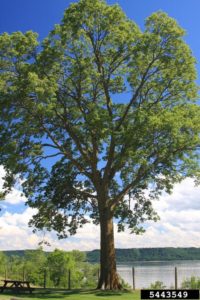
Credit: Steven Katovich, Bugwood.org
Scientific name: Celtis occidentalis
Native to: east-central U.S. (includes Wisconsin)
Mature Height*: 30’-60’
Spread*: 30’-50’
Form: broadly and irregularly oval, approximately the vase shape of American elm
Growth Rate*: medium to fast; up to 24”-36” per year
Foliage: 2”-5”; lopsided oval with serrated edge
Fall color: yellow-green to yellow
Flowers: inconspicuous; blooms late April to May
Fruit: ¼”-3/8” diameter; round; dark red-brown to purple; ripens September-October; favored by birds and other wildlife
Bark: gray with characteristic corky “warts” or ridges
Site Requirements: adaptable; withstands windy sites, pollution, a wide range of soil pH, and dry, compacted, sandy, or rocky soil
Hardiness zone: 3a
Insect & Disease Problems: none life threatening; subject to disfigurement by “witches broom” (brushy clusters of twigs sprouting from the trunk or branches); subject to nipple gall (wart-like projections of leaf undersides)
Suggested Applications: streets, parks, lawns, exposed areas
Limitations: transplant in spring
Comments: Hackberry can be slow to leaf out after transplanting, particularly bare root stock.
Cultivars: ‘Chicagoland,’ ‘Magnifica,’ ‘Prairie Pride’, and UltraTM reach 50’ high and 40’ wide; Prairie SentinelTM is columnar (45’ high and 12’ wide)
*Urban tree size and growth rate vary considerably and are strongly controlled by site conditions.
(This is an updated version of an article written by retired DNR Urban Forestry Coordinator Cindy Casey for the urban forestry newsletter in 1994.)
